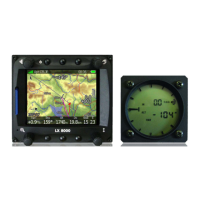LX8000 version 0.96 April 2008
Page 35 of 85
Electronic Total energy compensation
The LX8000 offers two methods of vario TE compensation.
• TE tube
• Electronic TE compensation
It is important to note that the method of TE compensation is set up when the
instrument is installed by virtue of the pneumatic connections made to the TE and
static ports. Changing the compensation type in the setup screen below WILL NOT
change the method of compensation - the pneumatic plumbing has to be changed
first (see chapter 6).
If the TE tube has been connected then TE compensation should be set to 0%.
There is no further adjustment of TE compensation possible. Quality of the TE
tube is the one and only factor.
If the electronic TE option has been installed, then TE compensation should be set
to 100%.
The TE compensation can be fine tuned during flight using the following procedure. It is
essential that this is only done in smooth air; it is not possible to tune the TE accurately in
turbulent air.
Select TE compensation to 100 % and TE filter to default. Accelerate up to approximately
160 km/h (75kts) and keep the speed stable for a few seconds. Gently reduce the speed to
80 km/h (45kts). Observe the vario indicator during the maneuver. At 160 km/h the vario
will indicate about –2 m/s (-4kts). During the speed reduction the vario should move towards
zero and should never exceed zero (slightly positive indications are acceptable). If the vario
shows a climb, then the compensation is too low, increase the TE%; and vice versa. Try
another “zoomie” to assess the change and make further adjustments if necessary.
The TE filter is the compensation delay. Larger numbers will increase the delay and vice
versa. During the first test is recommended to use TE filter 4.
Electronic TE is only effective when the pitot and static sources are co-located and the
pneumatic lines to the instrument are approximately the same length. The best sensor to
use is the combined pitot/static Prandtl tube. If problems are experienced with the electronic
TE compensation, then the most likely cause is the glider's static source. The static source
can be checked by plumbing the pneumatic tubes for electronic compensation and then
setting the TE: to 0%. In still air, accelerate to approximately 160 km/h and slowly reduce
the speed. Observe the vario indicator. If the static source is good, then the vario should
immediately start to move to show a climb. If the needle firstly shows increased sink and
then moves to a climb, the static source of the glider is unsuitable and there is no way to
provide successful TE compensation electronically. The use of a dedicated and accurate fin
mounted pitot/static source such as a Prandtl tube might help.
SC switch
The LX8000 has an input for an external speed command switch, which is wired to LX8000
vario unit. Using the external switch it is possible to switch between SC and Vario manually.
Setting the SC switch to ON means that closing the switch will cause the instrument to enter
SC mode, and setting SC switch to OFF means that closing the switch will select Vario mode.
There is a third option by setting SC INPUT to TASTER and connecting a push button to the
input, each key press will toggle between SC and Vario (mandatory setting for f LX Remote).

